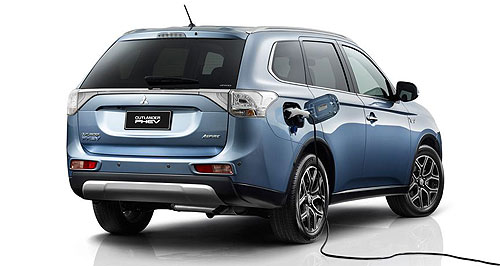Make / Model Search
News - Mitsubishi - Outlander - PHEVPlug-in ‘hangover’ made dealers wary: MitsubishiCharged: Mitsubishi says it had to convince dealers that it really meant business with its plug-in Outlander PHEV. Mitsubishi Outlander PHEV a hard sell to the public and its own dealers alikeGallery Click to see larger images 31 Mar 2014 UPDATED 17:00 AESTNEGATIVE experiences selling the Holden Volt and Nissan Leaf caused a number of multi-franchise dealers to think twice about putting their support behind Mitsubishi Australia and its new Outlander PHEV, according to the company’s marketing boss. Mitsubishi Motors Australia Limited (MMAL) executive director of marketing Tony Principe revealed to GoAuto last week that slow sales of the Volt, Leaf and Mitsubishi’s own i-MiEV – compounded by issues such as an absence of government incentives – had made retailers cautious and created a challenge for the company. “The reality is the network is very negative because (with) the Nissan Leaf and Holden Volt, and our own i-MiEV, their experiences haven’t been great because the Australian consumer is not prepared to pay for that technology,” Mr Principe said. “It means for them investment too. They’ve got to be able to service these cars, they’ve got to train their technicians, all that kind of stuff. “We’ve had to really swing them around and say, ‘Guys look, this is different, trust us’, and it hasn’t been easy. But we’ve got a good position now in terms of price and supply, and we’ve made the network understand that this is the future and eventually this technology will be in every car.” MMAL launched the long-awaited plug-in hybrid SUV last week after months of delay. The Japanese manufacturer only builds 4000 units per month, and has been reallocating Australia’s allotment to places with more demand such as the Netherlands. The PHEV has a similar configuration to the Volt, because unlike the pure-electric Leaf – and the previous i-MiEV – it has a supplementary petrol engine that acts as a generator. Rather than a volume seller, the car is being pitched as an image leader and brand builder. However, priced from a comparatively sharp $47,490 plus on-road costs – a figure that reduces the margin of each vehicle sale but is designed to counter the Australian market’s slow take-up of electrified vehicles – MMAL is confident it can make more of an impact than other pioneering EVs and PHEVs alike. The smaller, four-seat Volt is priced from $59,990, while the EV Leaf has been reduced to $39,990 drive-away. The i-MiEV, the last remaining examples of which were registered at the end of 2012, was priced from $48,800. That car technically remains on sale through special order, said Mr Principe, but MMAL is not bringing in any shipments, and will instead direct its resources to the PHEV. Important for MMAL is the fact that the Outlander PHEV is scarcely more expensive than an equivalent diesel-powered compact SUV – something no rival can claim. Significantly, MMAL is locked into this price until March 31, 2014, and in time hopes to pass on price cuts thanks to cheaper batteries. Greater production scale should allow Mitsubishi to negotiate a sharper supply deal from battery suppliers to counter any currency depreciation here. Mr Principe told GoAuto that MMAL had been hard-pressed to convince its Japanese parent to sell the PHEV at such a skinny price, but said it was crucial to ‘spread the word’ to the public, and convince its dealers to throw support behind the car. “We’re not going to wait around and rely on anybody, we’ve got to control our own destiny, we have got to get the cost down, that’s it – it’s the only way this can work ... (and) that took a lot of work,” he said. The big problem, said Mr Principe, was the fact that several PHEV markets offered significant subsidies for green cars, meaning there was more public interest and higher profit margins – the latter presumably down to the car-maker hiking up its prices and using the subsidy to come out ahead. “Japan is sending volume to markets with subsidies, and because of that they’re making huge margins because they can charge full total,” he said. “It’s a real battle here, because we’re diverting their volume from high-profit areas, but what we tell them is to treat it as an investment in brand building.” Despite the hype, Nissan sold only 188 Leafs in 2013 – nevertheless up 144.2 per cent thanks to the aforementioned price cut – while Holden sold 101 Volts, up 26.3 per cent.  Read more |
Click to shareMitsubishi articlesResearch Mitsubishi Outlander pricing
Motor industry news |





















Facebook Twitter Instagram